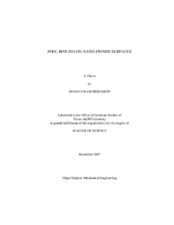| dc.description.abstract | The effect of nano-structured surfaces on pool boiling heat transfer is explored in this
study. Experiments are conducted in a cubical test chamber containing fluoroinert
coolant (PF5060, Manufacturer: 3M Co.) as the working fluid. Pool boiling experiments
are conducted for saturation and subcooled conditions. Three different types of ordered
nano-structured surfaces are fabricated using Step and flash imprint lithography on
silicon substrates followed by Reactive Ion Etching (RIE) or Deep Reactive Ion Etching
(DRIE). These nano-structures consist of a square array of cylindrical nanofins with a
longitudinal pitch of 1 mm, transverse pitch of 0.9 mm and fixed (uniform) heights
ranging from 15 nm – 650 nm for each substrate. The contact angle of de-ionized water
on the substrates is measured before and after the boiling experiments. The contact-angle
is observed to increase with the height of the nano-fins. Contact angle variation is also
observed before and after the pool boiling experiments.
The pool boiling curves for the nano-structured silicon surfaces are compared with that
of atomically smooth single-crystal silicon (bare) surfaces. Data processing is performed
to estimate the heat flux through the projected area (plan area) for the nano-patterned
zone as well as the heat flux through the total nano-patterned area, which includes the surface area of the fins. Maximum heat flux (MHF) is enhanced by ~120 % for the nanofin
surfaces compared to bare (smooth) surfaces, under saturation condition. The pool
boiling heat flux data for the three nano-structured surfaces progressively overlap with
each other in the vicinity of the MHF condition. Based on the experimental data several
micro/nano-scale transport mechanisms responsible for heat flux enhancements are
identified, which include: “microlayer” disruption or enhancement, enhancement of
active nucleation site density, enlargement of cold spots and enhancement of contact
angle which affects the vapor bubble departure frequency. | en |


